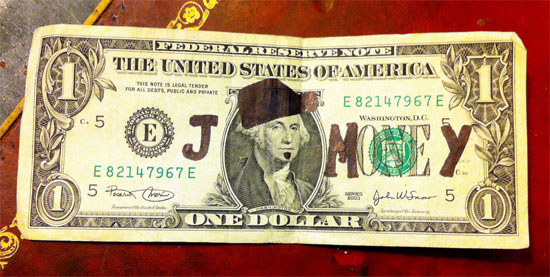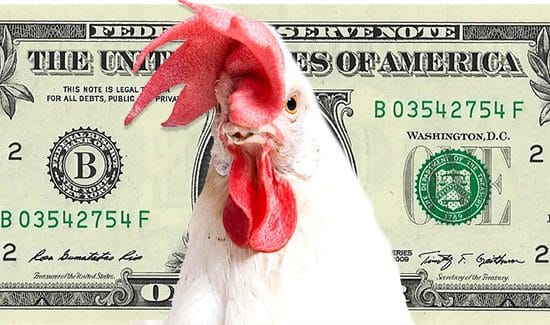(Guest Post by Trevor van Hemert)
Today I’d like to show how I trick myself into spending much less money without the need for budgeting. I use three different psychological tricks in three categories: Survival, Slavery, and Mileage. I’m giving you three so you can pick the one that best resonates with you!
But I’d like to start off by describing a well-known personal finance psychological trick. You’ve probably already heard of it.
The Debt Snowball
Decades before I was born, personal finance titan Dave Ramsey packaged and promoted a method of paying off debts called the “debt snowball.” In this method, you pay off your debts one at a time, from the smallest to the largest – regardless of interest rates on the individual debts.
The Debt Snowball method has been subjected to a lot criticism over the years ever since Ramsey has promoted it. After all, isn’t it more efficient to start with the highest interest rate debts first?
Eventually, SCIENCE weighed in on the long disagreement. Researchers at the Kellogg school of management studied the records of a debt collection company to reach an unbiased conclusion. It turns out Ramsey’s right – the Debt Snowball method has a much better success rate than any other method of paying down debts.
Let me say that in another way. More people succeed in paying down all their debts using Debt Snowball than an interest rate optimized strategy. When it comes to changing personal finance habits, psychology counts, not numbers. Those tiny early victories build stamina for the struggle ahead. Paying off that first debt feels monumental and lets you prove to yourself that debt-free is possible.
But paying down debt is just a small piece of the personal finance mosaic. Many readers of this blog don’t have any debt at all, and are just interested in building their savings. Well, good thing you’re still reading! Because I’ve got yet more psychological tricks to reduce spending, build savings and change how you think about your money.
I’m going to share three of my tricks with you. These techniques have helped me reduce my expenses enough to achieve self employment ,and an imminent early retirement in my 20’s. And they’re all so simple you can begin today!
Your Survival Number
Try this: calculate how much money you need for a decent survival each day. Count all important expenses, but aim to come up with as low a figure as possible. For me, this number is $26. That includes fancy things like an entire pot coffee every day, a nice apartment in frozen Alberta, and pretty damn good home cooked food. Your number may vary if you have kids, a spouse to support, soul crushing debt, etc.
Keep your survival number with you during your day. Write it on your hand if it helps. For most people, reducing expenses is about changing their day-to-day habits, not increasing their salary or saving a bunch of money on car insurance. Those small, easy-to-ignore expenses will seem much bigger when compared with your survival number.
For example, as I said my survival is $26. That delicious ten dollar burger? That’s almost half of a day’s survival budget! Ouch!
You can get more granular with it too, play around a bit. My fairly overpriced internet costs $2/day – which provides for almost all my entertainment and education needs. For what I get out of it, I consider it money well spent. But would I spend an entire day’s internet on a single Starbucks coffee?
How Many “Energy Slaves” Could That Buy?
Do you know what the best bargain for your money is? It’s the greatest deal of all time and it’s staring you right in the face every day when you go to work.
Gasoline.
That so-called “expensive” $4 per gallon gas embodies an incredible amount of energy that would make kings and emperors throughout history seethe with envy. A single gallon of gas contains 31,000 calories of energy.
I like to think of this in terms of slaves because gasoline powers our modern slave equivalents – cars, cargo ships and corn combines. Here’s what Wikipedia has to say on this:
An Energy Slave is that quantity of energy (ability to do work) which, when used to construct and drive non-human infrastructure (machines, roads… etc) replaces a unit of human labour (actual work). An energy slave does the work of a person, through the consumption of energy in the non-human infrastructure.
Now a single human slave would need 2,000 calories per day, which means a single gallon of gas is like having over fifteen slaves for a full 24 hour day. That’s about 26 cents per slave per day (talk about getting your 4 bucks worth).
Again, take this number and apply it to your every day purchases. It will start to make you sick how expensive some things are. I just bought 10 rolls of toilet paper for $10. Seems like a pretty good deal right? WRONG.
Each of those $1 rolls could have bought me a gasoline-powered energy slave for four days. That’s enough work to clean my house, cook all my meals, wash my dishes and give me a daily back massage for half a week.
Note: Obviously slavery itself is immoral and illegal, however these “energy slaves” I talk about is a common and well studied concept as noted above.
Tripling your Money Mileage
One last mental trick, ladies and gentlemen. This is a new one I’m developing so forgive me if it’s a bit undercooked.
Remember when I told you I spend $26/day for all my living expenses? For those of you who would rather not do the math, that’s $9,490 per year. It turns out the average adult in my country spends more than three times that. I found that out on the excellent Stats Canada website, which catalogs statistics like this.
Effectively what this means is I’ve increased my money mileage to three times the baseline. One dollar to me does three times more for me than it would do for a typical Canadian.
To do this math for your own household, divide the average expenditure for your household type in your state or province by your own expenses, and find your money mileage multiplier. As with all my previous tricks, take this number with you and integrate it into your routine. Revalue that $4 deli sandwich at $12, is it still worth it? The more you multiply, the less you’ll want to spend, which in turn will bring your money multiplier even higher!
It’s worth noting that this trick works best if your spending is below, preferably far below, the average.
The End Goal
These tricks are all meant to help you revalue your money. You’re not going to hang onto what you don’t prize highly – it’s the same in relationships as it is in personal finance.
I’ll happily admit that I’m not even close to an expert at reducing expenses – there’s folks over at Early Retirement Extreme who have dropped expenses down to $7/day, and that’s including children!
Run the numbers and tell us what your “survival number” is. Maybe you have other tricks too?
——————-
Trevor van Hemert makes things, mostly bad jokes and websites. His experiments litter the internet like corpses after a battle. By far the least terrible of these sites is about 5 gallon buckets. His newest tepid creation is about mason jars. [Authorship: Trevor+]
EDITOR’S NOTE: My “survival number?” A whopping $183. Damn…
[photo by NatalieMaynor]
Get blog posts automatically emailed to you!





LOVE the survival #. Wow, I thought I have heard of it all…but that one was good. Thanks for this!!
That was my fave one too actually – so crazy when you think of money that way!
It is amazing just how much we take for granted when it comes to oil. I remember reading somewhere a while back that conventional oil production peaked in 2004 and things like shale and tar sands are making up the gap.
What happens when these other oil sources also go into decline?
Good post! I’ve heard of this before and think it can be a very valuable thing to know for many. My wife and I did something similar when we started our business and set a minimum needs budget. It’s what we need to have food on the table and the lights on. It’s not to the extent that the survival number is, but it’s close.
My wife and I spend almost $40k every year. Between taxes and daycare we get run over the coals. But we are extremely thrifty in everything we do, and save way more than the average couple so can’t imagine what a typical American couple spends.
Yeah day care is insane!! We’re only doing it temporarily and it’s enough to make me want to vomit, haha…
When I decided to take a year off from work, I sat down to calculate what the minimum I needed each month and what I was willing to cut out. (Not much – ha!) The less I needed, the longer my “sabbatical” could be. No problem there. The challenge is sticking to that minimum now that I’m not working. More time to spend $$. Trevor is right about psychology wins every time. At least in my case!
That’s awesome! And totally the way to think like too – I’m on a “less money needed” binge right now over “needing to make more money!” – but rockin’ either (or both) is always nice.
Can you go into more detail on the “Survival Number?” This is something I have never heard of before!! Does that include things you dont use often like car/renters insurance?
Hey Mark!
Do you need a car to survive where you live? In many cities in the United States you do. If that’s the case I would factor it in. Is renter’s insurance required for where you live? It is for me, so I would factor it in. The aim is to achieve as low a number as possible while being honest with yourself about the expenses you need to keep your household running.
t
I love this :-) The survival number concept is similar to one I wrote a guest post on a few months ago, but related to interest costs. The idea on that one was how much do you have to pay as soon as you wake up, before you are even paying for anything tangible. ie – the price you pay just to be able to pay your mortgage.
I don’t want to know my survival number, it’s going to be a heckuva lot higher than yours, to live in frozen BC.
My survival number actually dropped when I moved away from Canada’s 2nd most expensive city, Victoria – to a town on the Alberta/Sasckachewan border. Now it’s actually shaping up to be 20$/day. So now I know that living in Victoria over other places will cost me 6$/day. Is that worth it? Probably!
I think anything that gets poeple to save more is a good idea. The survival number is a good way to look at things, it really brings them into perspective. $26 a day seems ridiculously low, but I know my spending isn’t as low as it could be. I like this new way of thinking about your money because I know budgets aren’t for everyone.
It seems low, but compared to many parts of the world it is extremely lavish.
You are so sensible. I miss who I used too be reading this.
yup – it’s a *different* way to pretty much still budget ;)
I love the thought of knowing my Survival Number. I basically try not to spend money during my work day. I buy a weekly travel card and try to bring my lunch everyday. This gives me a new way to look at it.
Not including school or debt my Survival Number is $21 a day, per 30 day period. I am currently testing that number out with a no-spending challenge in order to pay off my debt by April.
that’s great! you’re killing mine! :)
This one made my mind hurt a little. I have never thought of this, but it is awesome. Nice work. I didn’t use the snowball method and I was able to succeed.
I also love the survival number idea! With the husband, baby, and me, I think ours is much higher than $26…. somewhere between $50 and $100, though I’d have to collaborate with the hubs to figure out the exact number.
The only problem with the energy slaves idea is that now I’m going to feel bad about buying nice toilet paper!! ;)
I like the concept of a survival number. I’ve never looked at my expenses that way. I need to that as it ties in nicely with helping me develop a budget for when I go into “Semi-Retirement”. Having a baseline to work will be critical in understanding what I need to earn! Here’s a “Non-psychological way to save some money :D http://wisedollar.org/an-easy-way-to-save-on-your-heating-bill/
I love the sound of semi-retirement! I hope you do indeed make it as planned, friend!
Just calculated and i got 33 written in my hand as we speak, ill see if it helps haha
That’s awesome, haha… I’m not writing mine on there as it’s too depressing! ;)
Maybe you can make it your goal to achieve a double digit survival number! :)
That’s my goal every day :)
Nice, I like this! I do something similar for months but never have done it daily. Like Trevor mentioned, psychology is huge. If everyone was completely systematic and rational the whole world we be way different. It makes me wonder if I took what I allot myself for fun money every month and immediately took it out of the bank and put it in my pocket, would I spend it all or save it because I don’t want to run out. Just checked, 23 bones. Man the Midwest is cheap.
I tend to spend less money when it’s cold hard cash in my pockets – it’s too pretty to let go of fast! ;)
“Let me say that in another way. More people succeed in paying down all their debts using Debt Snowball than an interest rate optimized strategy.”
Glad I read that. I really do think that emotion is so much more powerful than cold hard math. Budgets are sexy, yes, but they can also be boring sometimes :( so you gotta switch up the way of thinking every now and then, and then get back to home base.
I like the survival number :)
(I heard that!)
I don’t think the Slave metaphor is appropriate or necessary to make a point on how much money you can save. It’s insensitive to say the least.
Won’t be reading or following your content any longer.
Sorry to hear that :(
Oops! My survival number, in a HCOL area, is 78. I did add donations, because that’s important to me. And yoga. Writing it on my hand right now. I don’t want this scary number to go up!
At least your number is half as scary as mine! :)
Love that you’re keeping charity & yoga in there…
What an interesting and different way of looking at it. I live in Southern California, this might be a big ouch! lol But it might be helpful with giving me the extra oomp to get those student loans paid off faster!
YOU CAN DO IT!!!
WE ARE ROOTING FOR YOU!!